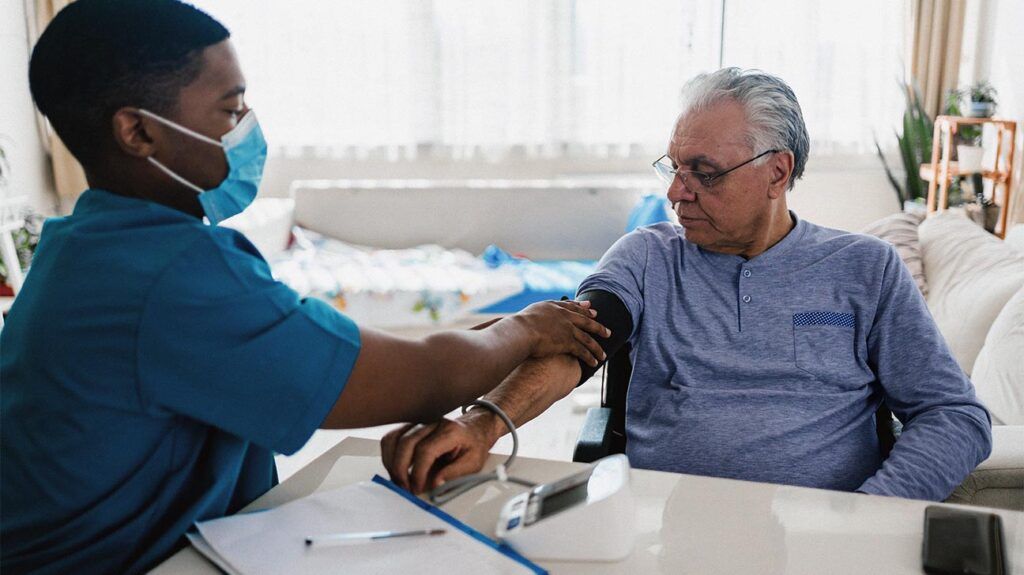Post-pandemic research shows there may be a link between COVID-19 and postural orthostatic tachycardia syndrome (POTS). One theory explains that the virus may cause the immune system to attack itself.
POTS affects several body systems, causing rapid heart rate, fatigue, and lightheadedness. While the condition is not life threatening, it can be debilitating and interfere with everyday activities.
Experts are still exploring the cause of post-COVID-19 POTS, why it happens, and its link to long COVID. Treatment may include increasing salt and water intake, exercise, and taking medication.
This article explores the connection between COVID-19 and POTS. Learn who is at risk, the link between COVID-19 vaccines and POTS, and how doctors diagnose and treat the condition.
Coronavirus data
All data and statistics are based on publicly available data at the time of publication. Some information may be out of date. Visit our coronavirus hub for the most recent information on COVID-19.

Long COVID, sometimes called chronic COVID-19 or post-acute COVID-19 syndrome, occurs when a person’s symptoms persist after recovering from a SARS-CoV-2 infection. They can develop a new set of symptoms that last for weeks, months, or even years.
One potential long COVID-19 complication is POTS, a condition that makes the heart beat faster than usual when a person stands up.
While COVID-19 mainly targets the respiratory system, it can also affect other organ systems, including the autonomic nervous system. Recent research suggests POTS may be one long-term consequence that starts within
Experts do not know precisely why some people develop POTS after COVID-19, but one theory suggests the virus may produce autoantibodies that attack the autonomic nervous system. Another theory suggests that spike proteins from the virus
The autonomic nervous system manages various automatic functions such as heart rate, blood pressure, and digestion. When this system becomes damaged, it
Anyone can get POTS after having COVID-19. However, certain people seem more likely to develop the condition.
According to current data, people who develop POTS are typically aged 18–45, and females are more likely than males to experience the condition. For every
Another study found that white females of childbearing age comprised more than
While several studies report POTS occurring after mRNA COVID-19 vaccination, the cause is unclear, and the evidence is not substantial.
In contrast, a recent study of 284,592 people found that the risk of POTS
Therefore, experts advise that all people who are able to will benefit from getting the COVID-19 vaccinations and boosters.
Symptoms of post-COVID POTS
Some signs of POTS to be aware of include:
- Cardiovascular symptoms: A person may experience a rapid heartbeat with palpitations when they stand up.
- Lightheadedness or dizziness: This typically occurs when moving from lying to standing and sometimes causes fainting.
- Fatigue: This is a feeling of extreme tiredness that may impact daily functioning.
- Gastrointestinal symptoms: Nausea, bloating, changes in stool habits, and other digestive issues may occur.
- Cognitive issues: Some people have brain fog, difficulty concentrating, and memory problems.
- Respiratory issues: A person may experience trouble breathing or chest pain.
- Psychological symptoms: Anxiety, depression, or trouble sleeping may occur.
- Temperature regulation problems: A person may sweat too much or too little.
- Bladder dysfunction: This can involve an increased frequency, urgency, and need to urinate at night.
- Skin changes: Hives, Raynaud’s phenomenon, or red-blue discoloration may appear.
Generally, diagnosing POTS
Lab tests may include checking thyroid function and autoimmune and plasma studies. Blood pressure tests may include checking the blood pressure levels while the person is lying down, sitting up, then standing.
The head-up tilt table test is the gold standard for checking for POTS. It involves measuring the blood pressure and heart rate while the bed tilts the person at different angles.
Managing POTS
- increasing salt and water intake
- incorporating aerobic exercises
- wearing compression stockings
- taking steps to improve the quality of sleep
- avoiding large, heavy meals
- avoiding heat exposure
- raising the head of the bed when sleeping
Doctors typically wait to prescribe medications to see if the above treatments yield improvements. If POTS is severe or symptoms do not change, the doctor may prescribe medications to help control the heart rate and increase blood pressure.
Some exercise can also help reduce symptoms of POTS, though this can be challenging due to the lower exercise tolerance people with this condition may have. Some examples of exercises that may be more tolerable and can help reduce symptoms involve:
- using a recumbent bike
- using a rowing machine
- swimming
If a person suspects they have post-COVID-19 POTS or are experiencing the above symptoms, it is important they consult a doctor.
A healthcare professional can run tests and give a correct diagnosis and treatment plan. Early intervention and management may improve the prognosis of the person experiencing POTS.
A few months after the COVID-19 pandemic began, doctors started noticing that some people developed long lasting symptoms of conditions relating to COVID-19. They called these conditions long COVID or chronic COVID-19.
One of these long COVID conditions is POTS, a group of symptoms relating to autonomic nervous system dysfunction. Symptoms may include fatigue, lightheadedness, and a fast heart rate. Some people with POTS have difficulty performing daily activities due to the severe symptoms.
Treatment may include lifestyle changes such as incorporating daily exercise, increasing water and salt intake, and improving sleep. Sometimes, a person also needs to take medications.
